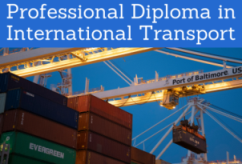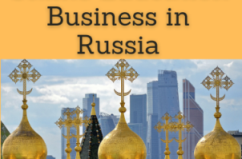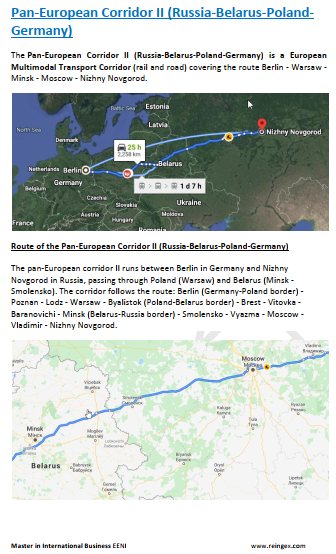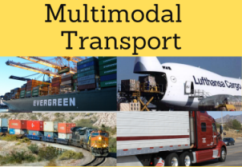Pan-European Corridor II

Pan-European Corridor II (Russia-Belarus-Poland-Germany)
- Introduction to the Pan-European Corridor II (Berlin, Warsaw, Minsk, Moscow, Nizhny Novgorod / Russia, Belarus, Poland, Germany)
- Member countries of the Corridor: Russia, Belarus, Poland, Germany
- Main features of the Pan-European Corridor II (Russia-Belarus-Poland-Germany)
- Access to:
- Trans-Siberian Railway (Russia, North Korea)
- International North-South Corridor
- Atlantic Corridor (Portugal-Germany)
- China-Russia Corridor
- Pan-European Corridor IX (Finland-Greece)
- Corridor of the Ashgabat Agreement
- Trans-European Corridors
- Baltic-Adriatic Corridor (Poland, Slovenia)
- North Sea-Baltic Corridor (Finland, Belgium)
- North Sea-Mediterranean Corridor (Ireland, France)
- Countries in the influence area of the Corridor: Denmark, Czech Republic, Austria, Slovakia, Ukraine, Hungary, Lithuania, Latvia, Estonia, Sweden, Finland
- The corridor and the New Silk Route

The Subject “Pan-European Corridor II (Russia-Belarus-Poland-Germany)” belongs to the following Online Programs taught by EENI Global Business School:
Logistics Courses: Road, Railway, Multimodal.

Diploma: International Transport.

Course: EU International Relations, Export to the EU, European Single Market.

Masters: International Transport International Business.
Doctorate: Global Logistics, World Trade.
Languages:  .
Summary in
.
Summary in  Corredor Paneuropeo II (Rusia-Bielorrusia-Polonia-Alemania)
Corredor Paneuropeo II (Rusia-Bielorrusia-Polonia-Alemania)
 Corridor paneuropéen II (Russie-Biélorussie-Pologne-Allemagne)
Corridor paneuropéen II (Russie-Biélorussie-Pologne-Allemagne)  Corredor Pan-Europeu II.
Corredor Pan-Europeu II.
Pan-European Corridor II (Russia-Belarus-Poland-Germany)

Pan-European Corridor II (Russia-Belarus-Poland-Germany).
The Pan-European Corridor II (Russia-Belarus-Poland-Germany) is a European Multimodal Transport Corridor (rail and road) covering the route Berlin - Warsaw - Minsk - Moscow - Nizhny Novgorod.

- Estimated time: 20 - 27 hours
- Distance: 2,258 - 2,289 km
Route of the Pan-European Corridor II (Russia-Belarus-Poland-Germany)
The pan-European corridor II runs between Berlin in Germany and Nizhny Novgorod in Russia, passing through Poland (Warsaw) and Belarus (Minsk - Smolensko). The corridor follows the route: Berlin (Germany-Poland border) - Poznan - Lodz - Warsaw - Byalistok (Poland-Belarus border) - Brest - Vitovka - Baranovichi - Minsk (Belarus-Russia border) - Smolensko - Vyazma - Moscow - Vladimir - Nizhny Novgorod.
- The crossing of the border between Germany and Poland is carried out without any formalities (Schengen Agreement of the EU)
- Customs border control at the Poland-Belarus (Brest) border
- Belarus and Russia are part of the State of the Union, so there is no border post between Russia and Belarus
- Gauge rupture on the border between Poland (western system, 1,520 mm) and Belarus (Russian system, 1,435 mm)
Countries in the influence area of the Corridor: Denmark, Czech Republic, Austria, Slovakia, Ukraine, Hungary, Latvia, Lithuania, Estonia, Finland and Sweden.
Related Routes:
- The pan-European corridor II is partly parallel to the European Highway E30. This road (6,530 km) starts from the port of Cork (Ireland) and reaches Omsk (Russia, near the Kazakhstan border)
- In the Russian territory, the pan-European corridor II continues parallel to the Trans-Siberian Highway and the Trans-Siberian Railway (Russia, Mongolia, China, North Korea) connecting with the AH6 Highway in Asia (which reaches the port of Busan, South Korea)
The Pan-European Corridor II (Russia-Belarus-Poland-Germany) connects with the New Silk Route.
Regional economic communities related to the Pan-European Corridor II (Russia-Belarus-Poland-Germany).
- Eurasian Economic Union: Armenia, Belarus, Kazakhstan, Kyrgyzstan and Russia
- Commonwealth of Independent States: Armenia, Azerbaijan, Belarus, Kazakhstan, Kyrgyzstan, Moldova, Russia, Ukraine, Tajikistan, Turkmenistan and Uzbekistan
- Organization for Cooperation between Railways (OSJD): Azerbaijan, Albania, Afghanistan, Belarus, Bulgaria, Hungary, Vietnam, Georgia, Iran, Kazakhstan, China, North Korea, South Korea, Cuba, Kyrgyzstan, Latvia, Lithuania, Moldova, Mongolia, Poland, Russia, Romania, Slovakia, Tajikistan, Turkmenistan, Uzbekistan, Ukraine, Czech Republic and Estonia
- OSCE: Albania, Andorra, Armenia, Bosnia and Herzegovina, Belarus, Georgia, the Holy See, Iceland, Liechtenstein, Macedonia, Monaco, Moldova, Montenegro, Norway, Russia, Serbia, Switzerland, San Marino, Turkey, Ukraine, Turkey, Ukraine
- Black Sea Cooperation: Albania, Armenia, Azerbaijan, Bulgaria, Georgia, Greece, Moldova, Romania, Russia, Turkey and Belarus
- Russia is a member of:
- Germany and Poland are a members of the Council of the Baltic Sea States (Belarus and Ukraine are observers)
- Belarus is a member of:
Related Trade Agreements
- Russia
- Trade Agreements of Russia: ASEAN, the EU, Andean Community, Armenia, Belarus, Azerbaijan, Georgia, Kyrgyzstan, Serbia, Moldova, Ukraine and New Zeeland
- Free Trade Agreement between Russia, Belarus and Kazakhstan
- Customs Union Russia-Vietnam
- Russia has a Trade Agreement with Cameroon
- Belarus
- Russia-Belarus Agreement
- Belarus-Ukraine Agreement
- Free trade agreement between Russia, Belarus and Kazakhstan
Main European institutions related to the corridor
- UNECE
- Regional Cooperation Council
- European Union Institutions;
- European Economic and Social Committee
- European Investment Bank
- European External Action Service
The main Religions of the region of the Pan-European Corridor II (Russia-Belarus-Poland-Germany) are:
The Pan-European Corridor II (Russia-Belarus-Poland-Germany) belongs to:

Corridors related to the Silk Route
- Bangladesh-Myanmar Corridor
- Asia-Africa Corridor
- Almaty-Bishkek Corridor
- Afghanistan-Turkey Corridor
- China-Central-Western-Asia Corridor
- Kyrgyzstan-Iran Corridor
- Islamabad-Istanbul Corridor
- China-Pakistan Corridor
- Europe-Caucasus-Asia Corridor
- Trans-Caspian Corridor
- Nanning-Singapore Corridor
- India-Afghanistan Corridor
(c) EENI Global Business School (1995-2024)
We do not use cookies
Top of this page



